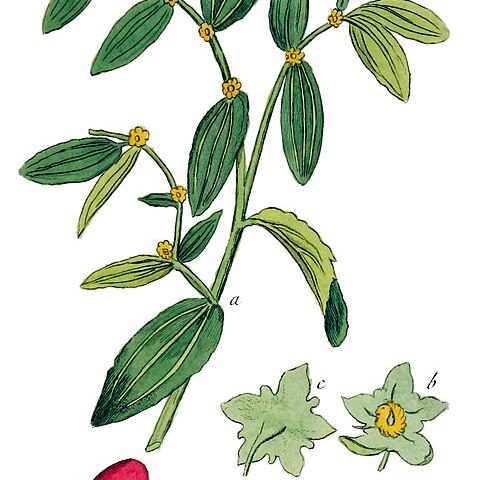Trees or shrubs (or scandent shrubs or almost lianes but not in East Africa), often armed by spinous stipules (or by branch-thorns but not in East Africa), the branchlets often zig-zag. Leaves alternate or opposite, petiolate; blades often 3-or 5-nerved from the base and penninerved above, often ovate or elliptic, with serrulate margins (or entire margins but not in East Africa). Stipules present, often at some nodes transformed into short spines, some of which are recurved, the stipules small, subulate and quickly deciduous at those nodes where they are not so transformed. Flowers 5-merous, bisexual, usually in axillary cymes or thyrselets, perigynous. Petals present (or absent but not in tropical Africa), clasping the stamens or at least at some stages clasping the filaments. Disk usually thickened near, but never coherent to, the sides of the ovary. Ovary 2–4-celled (3 cells are very rare and 4 cells absent in East Africa). Fruit a drupe with a single stone; cells 2 or 3 (or 4 but not in East Africa).
Shrubs or small to medium-sized trees, erect or straggling, often climbing, evergreen or deciduous, often spinose. Leaves alternate, petiolate, distinctly triplinerved or rarely pinnately veined; stipules usually transformed into 1 or 2, erect or ± recurved spines. Flowers yellow-green, small, bisexual, in axillary corymblike cymes, or axillary or terminal thyrses. Calyx tube shallow, patelliform to hemispherical. Sepals ovate-triangular or triangular, adaxially ± distinctly keeled. Petals clawed, obovate or spatulate, rarely absent. Disk shallow, fleshy, 5-10-lobed. Ovary superior, globose, 2-or 3(or 4)-loculed; style ± deeply branched, 2(-4)-fid. Fruit a single-stoned, (1 or)2-or 3-loculed, globose or oblong drupe, base with persistent calyx tube, apex mucronulate; mesocarp fleshy or soft corky; endocarp cartilaginous or woody, locules 1-seeded. Seeds without endosperm or rarely with endosperm; cotyledon thickening.
Evergreen or (in Australia) semideciduous shrubs, trees or lianes. Leaves alternate, petiolate, oblique, tripliveined; stipules free, usually persistent and becoming spinescent (often one straight and one curved). Inflorescences axillary, comprising small panicles of rhipidia; bracts persistent. Flowers bisexual, 5-merous, greenish. Hypanthium dish-shaped. Sepals spreading to recurved, caducous. Petals spreading to recurved, cucullate or longitudinally rolled, clawed. Stamens subequal to the petals, spreading to recurved. Disc conspicuous, filling the hypanthium, smooth or corrugate, glabrous or pubescent. Ovary inferior to half-inferior; carpels 2–4; style slightly lobed to distinctly branched, usually glabrous. Fruit a rather dry-fleshed drupe with several pyrenes and basal torus.
Shrubs or small trees, rarely lianas, mostly deciduous, frequently with stipular spines. Leaves alternate, rarely subopposite, 3-nerved, or rarely more or less pinnately nerved, mostly dentate; petiolate, the stipules mostly spinulose and unequal. Inflorescences cymose, axillary, few-flowered, rarely thyrses and terminal. Flowers bisexual; floral tube shallow; sepals (4-)5, keeled, deciduous; petals (4-)5, clawed; stamens (4-)5, longer than the petals; nectariferous disc surrounding the ovary; ovary inferior to subinferior at anthesis, becoming superior in fruit, 2(-3)-locular, the style 1, the stigmas 2(-3), small. Fruit a drupe, ovoid to more or less obovoid; seed 1, ellipsoid.
Leaves alternate, petiolate; lamina with margin dentate to serrulate, often markedly asymmetric at the base, with 3–5 nerves from the base; stipules frequently spinescent.
Ovary immersed in the disk and adnate to the receptacle, 2(4)-locular; ovules 1 in each loculus; style 2(4)-lobed.
Disk flat, covering the receptacle, 5–10-lobed or rarely entire, with margin free.
Fruit a drupe with fleshy exocarp and woody endocarp, (1 )2(4)-seeded.
Cymes axillary or rarely terminal, sessile or pedunculate.
Stamens 5, inserted under the edge of the disk.
Petals 5 (or absent), cucullate.
Seeds with a thin shining testa.
Flowers bisexual, pedicellate.
Trees, shrubs or shrublets.
Receptacle obconic.
Sepals 5.

